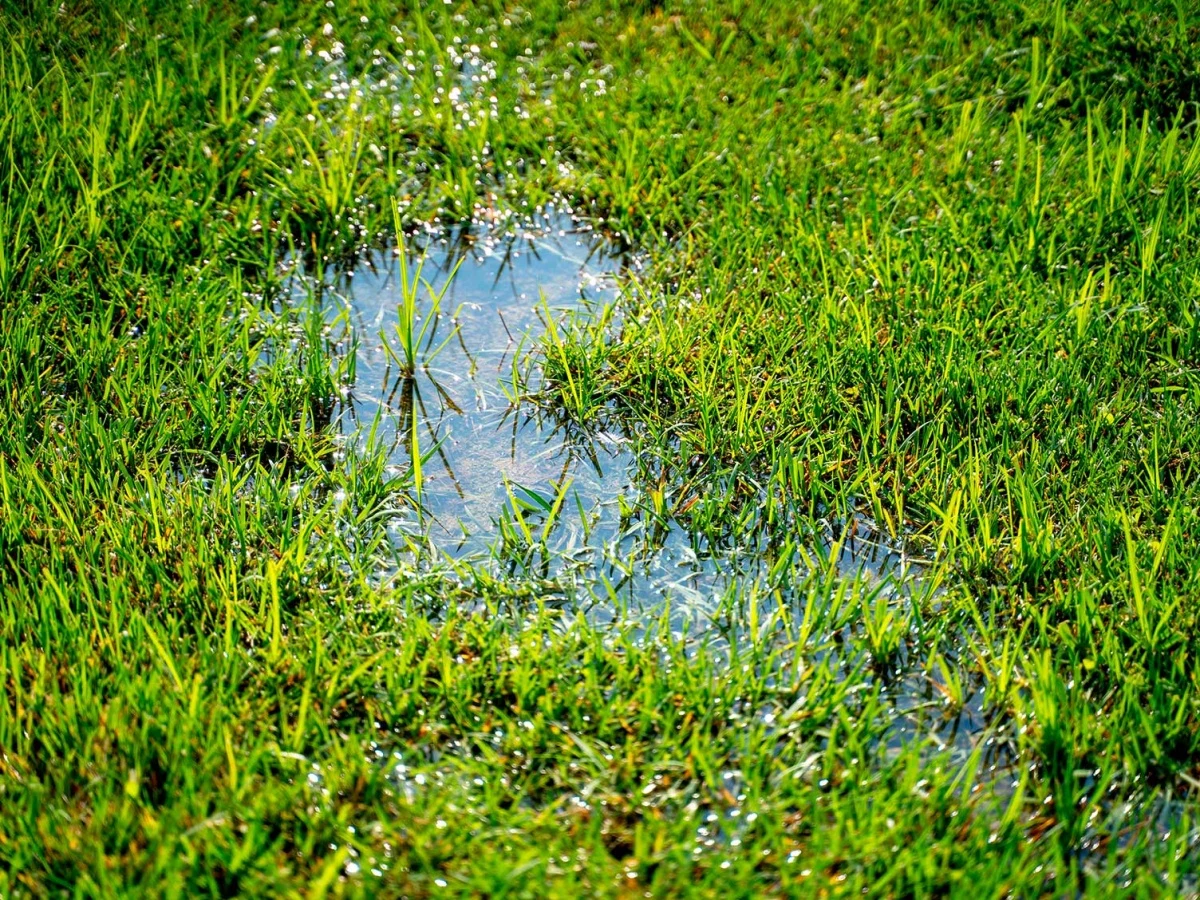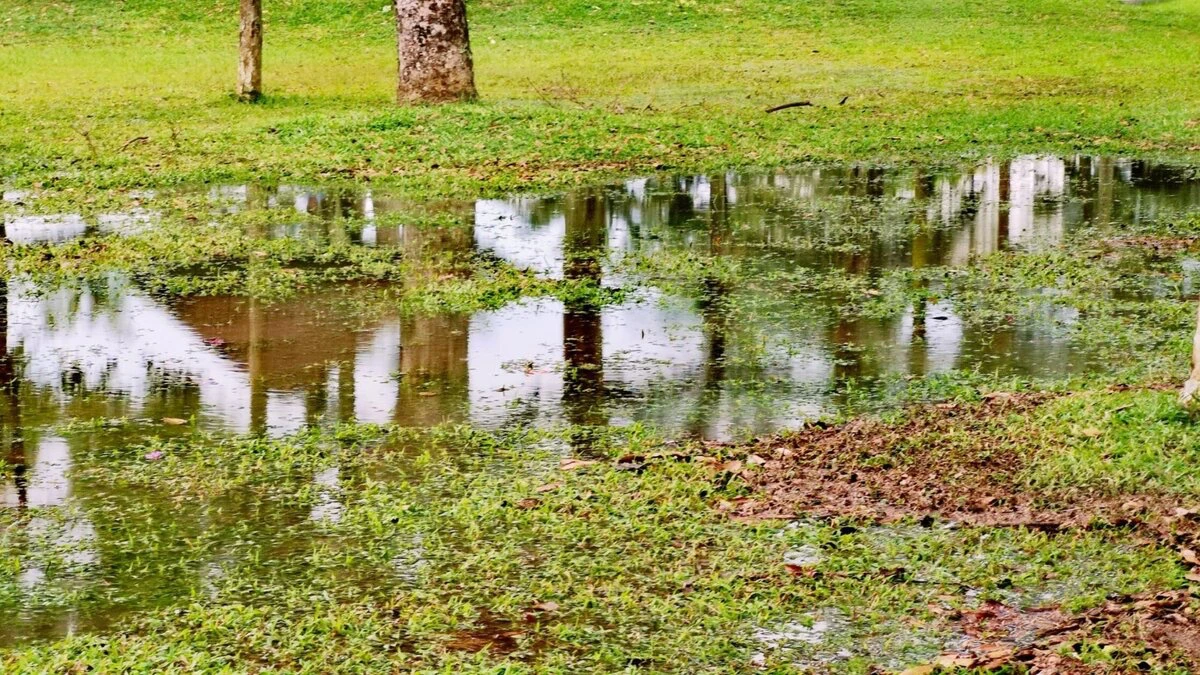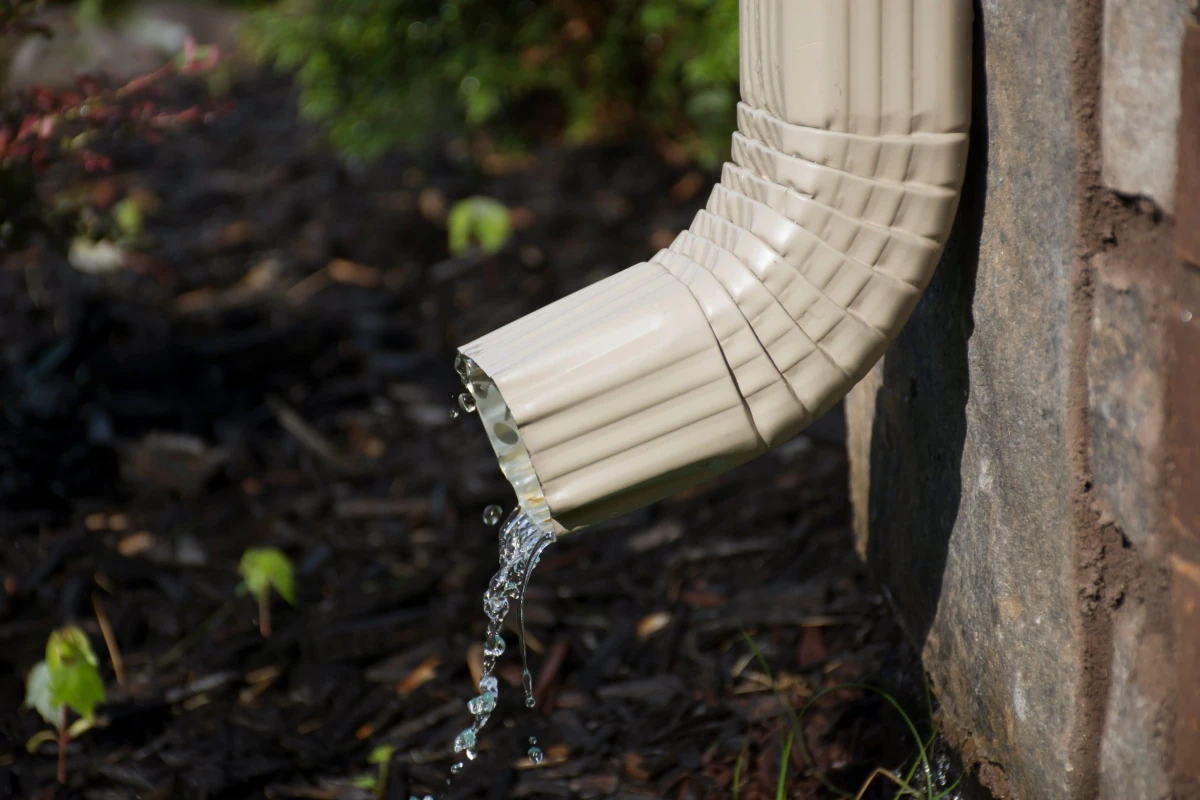Sick of Squishy Grass? Here’s How to Fix Your Waterlogged Lawn for Good
I’ve been working with lawns for a long time, from pristine golf courses to regular backyard gardens. And in all that time, the one problem that drives homeowners absolutely nuts is a waterlogged lawn. You know the feeling—that squelching, swampy mess that turns your yard into a muddy pit you’re scared to walk on.
In this article
- First, Let’s Figure Out Why It’s a Swamp
- Your First Step: The Simple Drainage Test
- Your 15-Minute Quick Win: Check Your Downspouts
- The Real Fix: The Power of Core Aeration
- Level Up: Topdress Right After You Aerate
- The Golden Opportunity: Spread Some Seed!
- When You Need a More Serious Fix
- Your Project Shopping List
- A Final Thought: Be Patient
- Inspirational Gallery
I once helped a guy in a newer housing development who was at his wit’s end. The builders had scraped off all the good topsoil, leaving him with compacted clay that drained about as well as a concrete slab. His kids couldn’t play outside, and this weird, sour smell was starting to waft up from the ground. It was a classic case of bad soil structure, and it taught me that you have to fix the root cause, not just skim the surface.
A soggy lawn is way more than just an inconvenience. When water pools on the surface, it suffocates your grass by filling all the tiny air pockets the roots need to breathe. Without oxygen, the roots die back, leaving your lawn weak and vulnerable. That constant moisture is also a welcome mat for moss, algae, and all sorts of fungal diseases. Before you know it, your yard is a sad patchwork of bare spots and gunk. This guide is built from that hands-on experience to help you figure out what’s wrong and, more importantly, how to actually fix it.

First, Let’s Figure Out Why It’s a Swamp
Before you lift a finger, you need to understand what’s going on beneath the surface. Waterlogging almost always comes down to one of two things: your soil’s structure or the shape of your yard.
Healthy soil is like a sponge. It has a mix of mineral bits and organic matter with plenty of empty spaces (pores) that hold both air and water. When it rains, water should fill these pores and then gradually drain away. When it can’t, you get a swamp.
The Usual Suspect: Soil Compaction
Most of the time, the main culprit is heavy, compacted soil. If your soil is mostly clay, it’s made of tiny, flat particles that stick together, leaving very little room for water to pass through. Over time, things like foot traffic, heavy lawnmowers, or even the kids’ soccer games squeeze these particles even tighter. This creates a rock-hard layer, often called a hardpan, that acts like an underground barrier. Water hits this layer and just sits there, drowning the roots from below.

When the soil stays saturated, it goes anaerobic—meaning it runs out of oxygen. All the good microbes die off, and nasty, anaerobic bacteria take over. They’re the ones that produce those toxic-to-roots compounds and that distinct, sour, swampy smell. It’s a downward spiral for your soil’s health.
Your First Step: The Simple Drainage Test
Okay, before you start buying tools or materials, let’s play detective. You need to know just how bad the problem is. This simple percolation test will give you a real, hard number on your soil’s drainage speed.
Here’s what you do:
- Dig a Hole: Find the soggiest spot in your lawn and dig a hole about a foot wide and a foot deep. Try to keep the sides straight.
- First Soak: Fill the hole to the top with water and let it drain completely. This pre-saturates the surrounding soil so you get an accurate reading on the next step.
- Test and Time It: Fill the hole with water again, right to the brim. Lay a stick or ruler across the top and measure the water level. Now, start a timer.
- Check the Rate: Check the water level every hour. Ideally, healthy soil should drain at a rate of about one inch per hour. If the water has barely budged after four hours, you’ve got a significant drainage issue. And if there’s still water in that hole 24 hours later? You’re definitely dealing with heavy clay or severe compaction.
This little test tells you if the problem is everywhere or just in one low spot. That’s critical info for what comes next.

Your 15-Minute Quick Win: Check Your Downspouts
Heads up! If you’re feeling a bit overwhelmed and just want one easy thing you can do right now, this is it. Go outside and look at where your gutter downspouts are pointing. A single downspout can dump hundreds of gallons of water into one small area during a heavy rainstorm. Often, a soggy patch is caused by nothing more than a poorly aimed downspout.
The fix? It’s usually super simple and cheap. You can get a flexible plastic extender for $10-$20 at any home improvement store. Attach it to the end of your downspout to redirect all that water away from the lawn and onto a driveway or into a garden bed that can handle it. It’s the biggest bang for your buck and might solve more of the problem than you think.
The Real Fix: The Power of Core Aeration
Once you’ve confirmed a drainage issue, the single most effective thing you can do is aeration. This just means creating holes in the lawn to break up compaction and let air, water, and nutrients finally reach the root zone.

But not all aeration is created equal. Let’s break it down.
- Spike Aeration: This is when you use a garden fork or one of those rolling spikers to just poke holes in the ground. Honestly, it’s better than nothing, but it’s a temporary fix at best. Pushing a solid spike into the ground can actually make the soil more compacted along the sides of the hole.
- Core Aeration: This is the professional standard, and for good reason. A core aerator (or hollow-tine aerator) uses hollow tubes to pull out small plugs, or “cores,” of soil. It doesn’t just poke a hole; it physically removes the compacted soil, creating lasting channels for air and water. This is the method you want to use.
A Quick Word on Timing and Cost
You should only aerate when your grass is actively growing so it can recover quickly—that means spring or fall for cool-season grasses (like fescue) and late spring/early summer for warm-season grasses (like Bermuda). The soil should be moist, but not soaking wet. A day after a light rain is perfect.

Now for the cost. You can rent a walk-behind core aerator from a place like Home Depot or a local tool rental shop. Expect to pay around $70 to $100 for a half-day rental. Be warned, these machines are heavy and can be a real workout, so plan for a solid 2-4 hours for an average-sized lawn. A lawn service might charge you $150 to $250 to do it for you, which can be well worth the money if you’re short on time or energy.
Oh, and what if your lawn is a constant swamp? Try to find a dry spell in the forecast. If that feels impossible, focus on the downspout fix first to see if you can get the area dry enough to work on.
Level Up: Topdress Right After You Aerate
Aerating punches the holes; topdressing fills them with good stuff. Doing one without the other is a huge missed opportunity. Topdressing is just spreading a thin layer of a beneficial mix over your lawn.

A great all-purpose recipe is a 50/50 blend of high-quality compost and coarse horticultural sand. The compost adds organic matter and feeds the soil, while the sand creates permanent pore space for better drainage.
A CRITICAL WARNING about sand: Please, do not just go buy play sand and spread it on your clay lawn. I once saw a guy do this, and he essentially created a layer of low-grade concrete under his grass. It was a disaster. The fine clay particles will surround the sand and set like a brick. You must use coarse, sharp sand and it must be mixed with an equal or greater amount of compost. If you’re unsure, just using pure compost is a much safer bet.
Immediately after aerating, spread a light layer (about a quarter-inch) of your mix. For a 1/4-inch layer, you’ll need about 0.75 cubic yards of mix per 1,000 sq ft of lawn. Don’t buy this in bags—it’ll cost a fortune. Call a local landscape or garden supply yard; they sell it in bulk and it’s way cheaper.

By the way, when you core aerate, your lawn will be covered in little dirt plugs. I know it looks messy, but trust me, just leave them. They’ll break down in a week or two, especially if you mow over them, and they act like a free little dose of fertilizer for your lawn.
The Golden Opportunity: Spread Some Seed!
While you have all those beautiful holes in your lawn from aerating, don’t miss the chance to thicken up your turf. This is the absolute BEST time to overseed. The seed falls directly into the holes, giving it perfect seed-to-soil contact, which dramatically increases the germination rate. It’s the single most effective way to get a thicker, healthier lawn.
When You Need a More Serious Fix
If you’ve aerated, topdressed, and fixed your downspouts but still have a pond in your yard, you might be dealing with bigger issues like a high water table or the basic topography of your land.

For minor low spots, you can gradually build them up over a few seasons with topdressing. For a more significant dip, you can carefully cut and lift the turf, fill the depression with a good topsoil/compost mix, and then lay the turf back down. Water it like new sod for a couple of weeks.
But for severe, widespread issues, you might need a French drain. This is an underground trench with a perforated pipe that collects groundwater and diverts it away. To be frank, this is almost always a pro’s job. It requires careful planning to get the slope right (at least a 1% grade), avoiding underground utility lines (ALWAYS call 811 before you dig!), and a whole lot of back-breaking labor. A poorly installed drain is worse than no drain at all. If you think you need one, get quotes from experienced landscaping contractors.
Your Project Shopping List
Ready to tackle this? Here’s a rough idea of what you’ll need for the aeration and topdressing project:

- Core Aerator Rental: $70 – $100 for a half day.
- Topdressing Mix (Compost/Sand): Varies wildly by location, but expect around $30 – $50 per cubic yard from a landscape supply yard.
- Grass Seed (for overseeding): A quality bag can run $40 – $80, depending on the blend and size.
- Wheelbarrow, Shovel, Landscape Rake: You probably have these, but if not, budget accordingly.
- Downspout Extender: $10 – $20 at a hardware store.
A Final Thought: Be Patient
Remember, you’re working with a living ecosystem. You won’t fix a badly damaged lawn overnight. It can take a full season or two of consistent effort for your soil’s health to truly bounce back. But by tackling the root cause—that compacted, lifeless soil—you’re building a resilient foundation for a lush, green lawn that your family can actually enjoy. The satisfaction of transforming that muddy pit back into a beautiful space is totally worth it.
Inspirational Gallery
Don’t turn a drainage problem into a landscaping nightmare. A common mistake homeowners make with heavy clay soil is adding sand, hoping to lighten it. In reality, this can have the opposite effect, creating a concrete-like substance that’s even less permeable. The sand particles simply fill the tiny gaps between clay particles, resulting in a dense, brick-like mixture. Stick to organic matter like compost, which truly improves soil structure.
A single earthworm can process its own body weight in soil every day, creating tunnels that are essential for aeration and water drainage.
This highlights why a healthy, living soil is your best defense against waterlogging. Chemical overuse can harm this subterranean workforce. Encouraging a robust worm population by adding organic compost is a long-term, natural solution to improving how your lawn handles water.
Is your lawn mower leaving ruts?
If you see tracks from your mower long after you’ve finished cutting, it’s a clear sign of underlying compaction. The weight of the machine is squeezing water out of saturated soil. Before considering major earthworks, try core aeration. A rented core aerator will pull out plugs of soil, creating channels for air and water. For the best results, do this in the autumn and follow up by top-dressing with a fine layer of quality compost.
- Reduced mosquito breeding grounds.
- Deeper, more resilient grass roots.
- A pleasant, earthy smell instead of a sour, swampy odor.
The secret? It’s not just about removing water, but about inviting air in. Aerating and amending the soil doesn’t just fix drainage; it revitalizes the entire soil ecosystem, leading to a lawn that is healthier and more enjoyable in every way.
Core Aeration: Uses hollow tines to pull out small plugs of soil and thatch. This is the most effective method for relieving serious compaction in clay soils, creating lasting channels for air and water.
Spike Aeration: Simply pokes holes in the ground with solid tines. While easier and cheaper, it can actually increase compaction around the holes over time. It’s best for light maintenance on already healthy lawns, not for solving a waterlogging issue.
For a truly swampy lawn, core aeration is the undisputed champion.
When surface solutions aren’t enough, it’s time to consider a French drain. This isn’t just a ditch; it’s a cleverly engineered system for redirecting subsurface water. Here’s what’s involved:
- A sloped trench, at least 8-12 inches deep.
- A layer of washed gravel at the bottom.
- A perforated pipe (like a 4-inch corrugated ADS pipe) laid on the gravel.
- The trench is then filled with more gravel, covered with landscape fabric, and topped with soil and turf.
According to the EPA, a rain garden can absorb up to 30% more water than a conventional patch of lawn.
Turn that perpetually soggy corner of the yard into a beautiful, functional feature. A rain garden is a shallow depression planted with water-loving, deep-rooted native plants that help soak up excess runoff. Consider planting hardy species like Siberian Iris (Iris sibirica), Ostrich Fern (Matteuccia struthiopteris), or colorful Bee Balm (Monarda) to create a mini-wetland that’s both an ecological asset and a visual delight.
The Gypsum Trick: If your waterlogging is due to heavy clay soil, gypsum can be a game-changer. Unlike sand, gypsum is a soil conditioner (calcium sulfate) that causes clay particles to clump together. This process, called flocculation, creates larger pore spaces, improving both water drainage and air circulation without drastically changing the soil’s pH. It’s a slow-acting but effective amendment when aerating.
- Pungent, sour, or rotting smells rising from the turf.
- Spongy texture underfoot, even days after rain.
- A proliferation of mushrooms, moss, or slimy green algae.
- Yellowing grass blades and bare patches that won’t recover.










